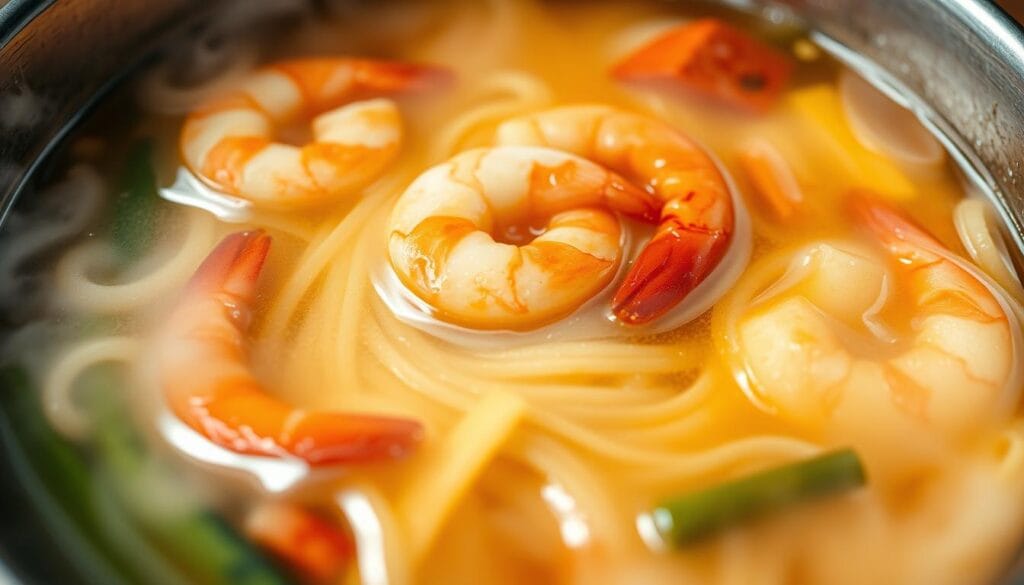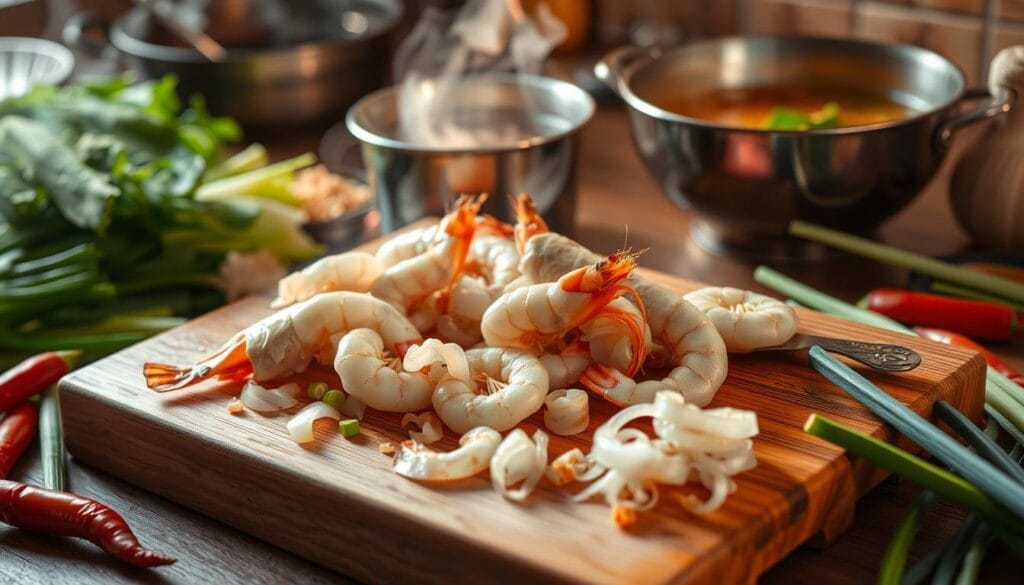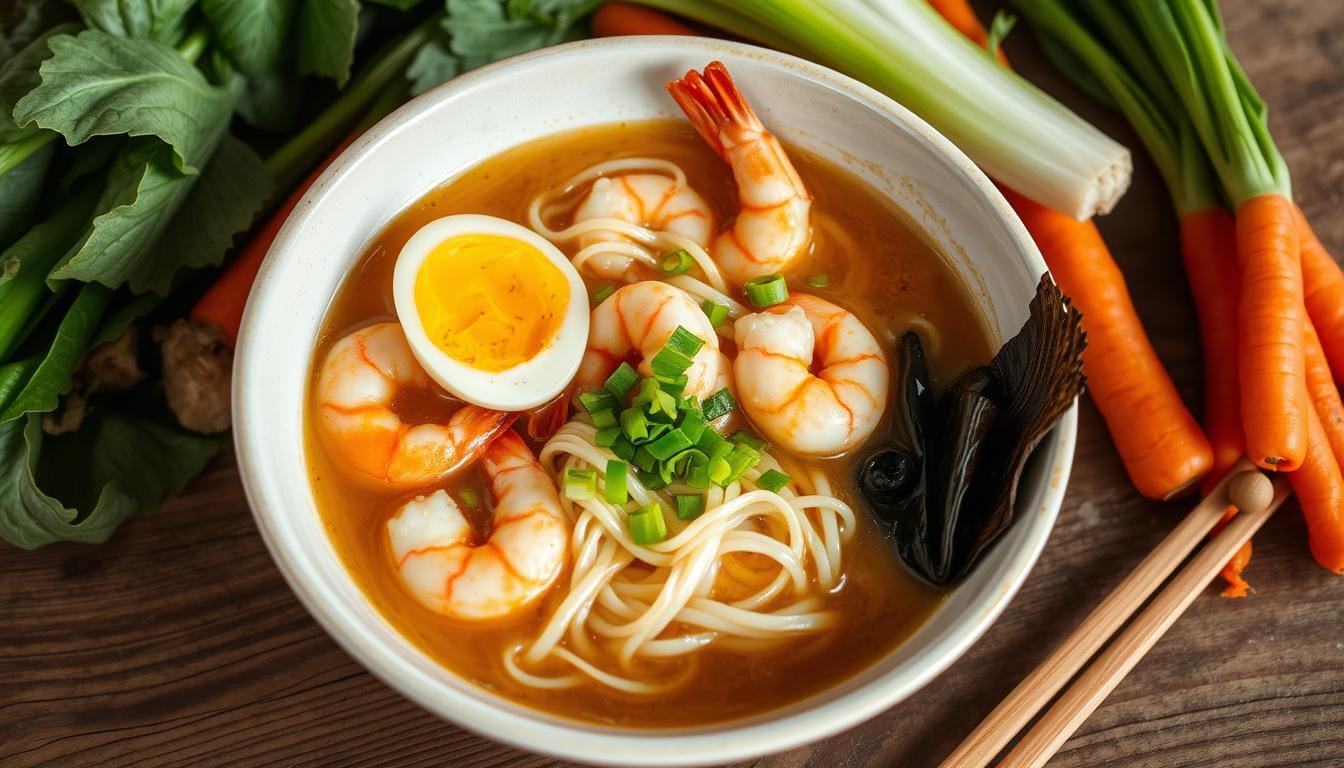How to make shrimp ramen from scratch.
The first time I made shrimp ramen from scratch, my kitchen became a place of culinary adventure. The smell of broth and sizzling shrimp filled the air. It promised a meal that would warm both body and soul. Shrimp ramen recipes are more than just food; they’re a way to express yourself creatively.
Making shrimp and ramen noodles at home is like creating art. It connects you to the rich traditions of Asian cuisine. Whether you’re looking for comfort or want to try new things, this guide will show you how to make perfect shrimp ramen.
Table of Contents
Understanding Basic Shrimp Ramen Components
Making a great seafood boil ramen starts with knowing its basic parts. A tasty ramen recipe seafood dish needs each ingredient to work together well. This makes a meal that’s both harmonious and flavorful.
Types of Ramen Noodles
Choosing the right noodles is key when making seafood boil ramen. There are many types that are perfect:
- Fresh wheat noodles
- Dried ramen noodles
- Frozen instant noodles
- Gluten-free alternatives
Shrimp Selection and Preparation
Picking high-quality shrimp is important for your ramen. Look for:
- Fresh or frozen king prawns
- Size: Medium to large (around 200g per serving)
- Shell-on or peeled options
“The secret to great seafood ramen is selecting the freshest shrimp possible.” – Culinary Expert
Essential Base Ingredients
Your seafood boil ramen needs a strong base of ingredients:
| Category | Recommended Ingredients |
|---|---|
| Protein | Shrimp, soft-boiled eggs |
| Vegetables | Pak choi, carrots, green onions |
| Seasonings | Garlic, ginger, soy sauce |
Knowing these parts helps you make a seafood boil ramen that’s full of flavor. It will impress everyone with its authentic taste.
Equipment and Kitchen Tools Needed
Preparing delicious shrimp ramen recipes needs the right kitchen tools. Your cooking journey begins with choosing the right equipment. This will help you make a perfect meal efficiently.
Before starting your shrimp ramen recipe, collect these key kitchen tools:
- Large stockpot (6-8 quart capacity)
- Heavy-bottomed saucepan
- Sharp chef’s knife
- Cutting board
- Wooden spoon or cooking chopsticks
- Colander for draining noodles
- Measuring cups and spoons
Your large stockpot is key for making a rich broth. This broth is what makes shrimp ramen recipes stand out. The heavy-bottomed saucepan prevents scorching when making delicate sauces and reducing broths.
“The right tools transform cooking from a chore into a culinary art.” – Professional Chef
For precise shrimp preparation, get a quality chef’s knife. Sharp knives ensure clean cuts and safer cooking. A reliable cutting board protects your countertops and gives a stable surface for prep.
Wooden spoons or cooking chopsticks are great for gentle stirring. They help avoid damaging delicate noodles. Your colander is crucial for perfectly drained ramen. It prevents a soggy texture.
Creating the Perfect Ramen Broth Base
Making a great shrimp and ramen noodles dish starts with a rich broth. The base of any seafood boil ramen recipe is key. It turns simple ingredients into a culinary masterpiece.
A remarkable ramen broth needs detail and flavor-building skills. The process has several steps that make your dish stand out.
Kombu Dashi Stock Preparation
Making kombu dashi stock is an art that adds depth to your dish. Here’s how to get the most flavor:
- Select high-quality dried kombu seaweed
- Gently wipe the kombu with a damp cloth
- Soak in cold water for 30 minutes
- Heat water slowly, removing kombu before boiling
Incorporating Shrimp Heads for Flavor
Using shrimp heads in your broth brings out intense seafood flavors. Pro tip: Roast shrimp heads first. This makes them sweeter and adds depth to your broth.
Seasoning and Aromatics
Enhance your shrimp and ramen noodles with the right seasonings:
- Minced garlic (6 cloves recommended)
- Fresh ginger (1 tablespoon)
- Tamari or soy sauce (1/3 cup)
- Lime juice (1/4 cup)
“The secret to an exceptional ramen broth is layering flavors with patience and precision.” – Ramen Master
When making your broth, consider these cooking methods:
| Cooking Method | Total Time |
|---|---|
| Slow Cooker | 6 hours on low |
| Stovetop | Approximately 2 hours |
| Instant Pot | 15 minutes high pressure + 1 hour natural release |
A great seafood boil ramen recipe balances flavors. It takes time to make a rich, complex broth. This makes your dish unforgettable.
Preparing Fresh Ingredients
Making a great ramen recipe seafood dish begins with preparing your ingredients well. Your prep work is key to the dish’s quality and taste. Fresh ingredients are essential for rich, true flavors that make your seafood ramen special.
- Vegetables: Baby portobello mushrooms, bok choy, spinach
- Aromatics: Fresh ginger, garlic cloves
- Proteins: Fresh shrimp, optional soft-boiled eggs
- Garnishes: Scallions, lime slices
Vegetable prep needs careful attention. Cooking baby portobello mushrooms takes 6 to 8 minutes to achieve perfect tenderness. Use canola oil, with its high smoke point, for the best results when sautéing.
“Freshness is the secret ingredient that transforms a good ramen into an extraordinary culinary experience.”
Timing is key in making your seafood ramen. Here’s a quick guide to cooking times:
| Ingredient | Cooking Time | Temperature |
|---|---|---|
| Shrimp | 4-6 minutes | Medium-high heat |
| Garlic/Ginger | 1 minute | Low heat |
| Vegetables | 6-8 minutes | Medium heat |
Pro tip for your ramen recipe seafood: Always prep your ingredients before cooking. This makes the cooking process smooth and stress-free.
Best Shrimp Ramen Recipes
Exploring shrimp ramen recipes is a fun journey for anyone who loves cooking and seafood. Whether you want a traditional Japanese dish or a quick meal, these recipes will make your kitchen a ramen paradise.
Ramen fans can find three unique shrimp ramen recipes. They cater to different tastes and schedules. Each recipe adds its own special flavor and cooking method to your meals.
Traditional Japanese Style Shrimp Ramen
Authentic Japanese shrimp ramen recipes focus on light flavors and careful preparation. Key ingredients include:
- Fresh large shrimp (1.5 pounds)
- Kombu dashi stock
- Ramen noodles
- Soft-boiled egg
- Nori seaweed
Spicy Asian Fusion Shrimp Ramen Recipe
The spicy Asian fusion version offers bold flavors. It combines intense tastes with seafood boil ramen techniques. Ingredients include:
- Gochujang sauce
- Fresh shrimp
- Sriracha
- Green onions
- Sesame oil
Quick 15-Minute Shrimp Ramen
This rapid shrimp ramen recipe is perfect for when you’re short on time. It uses instant ramen noodles and precooked shrimp for a quick, tasty meal.
Pro tip: Always cook shrimp for 4-6 minutes until they turn pink for perfect texture.
Your shrimp ramen journey begins here. Try these recipes and find your favorite seafood noodle mix!
Cooking the Noodles Perfectly

Learning to cook ramen noodles right can make your shrimp ramen amazing. It’s all about being precise and paying close attention. You want the noodles to be just right, not too hard or too soft, to match the tasty shrimp.
Here are some key tips for cooking ramen noodles perfectly:
- Cook noodles 1-2 minutes less than package instructions for firmer texture
- Use rapidly boiling water for optimal cooking
- Stir noodles gently to prevent sticking
- Drain immediately after cooking to stop the process
“The secret to great ramen noodles is respecting their delicate nature and avoiding overcooking.”
Water temperature is very important for shrimp ramen noodles. Make sure your water is boiling before adding the noodles. This ensures they cook just right, without becoming mushy.
Remember these tips for the best results:
- Separate the noodles gently before adding to water
- Use a timer to track precise cooking duration
- Taste test noodles for desired firmness
- Rinse with cold water to stop cooking process
Pro tip: Fanning the noodles after two minutes of cooking can help achieve a firmer, more authentic texture that holds up perfectly in your shrimp ramen broth.
Seasoning and Sauce Options
Improving your shrimp ramen recipes means choosing the right seasonings and sauces. The perfect sauce can make a simple ramen dish into a special treat. Let’s look at some tasty sauce options that will make your seafood ramen unforgettable.
Homemade Sesame Peanut Sauce
Making a rich, nutty sauce can really boost your shrimp ramen. Here’s a simple recipe for a delicious sesame peanut sauce:
- 4 tablespoons creamy peanut butter
- 2 tablespoons low-sodium soy sauce
- 1 tablespoon rice vinegar
- 1 teaspoon sesame oil
- 1 tablespoon honey
- Sriracha to taste
Soy-Based Tare Sauce
A classic tare sauce brings depth and umami to your ramen. Mix these ingredients for a balanced, savory sauce:
| Ingredient | Quantity |
|---|---|
| Low-sodium soy sauce | 3 tablespoons |
| Mirin | 2 tablespoons |
| Sake | 1 tablespoon |
| Sugar | 1 teaspoon |
Spice and Heat Variations
Change up your shrimp ramen’s flavor with these spice options:
- Mild: Ginger and light soy sauce
- Medium: Gochujang and chili oil
- Spicy: Ghost pepper sauce or habanero paste
“The secret to great ramen is balancing flavors and finding your perfect sauce combination.” – Ramen Chef
Try out these sauces to make a shrimp ramen that’s just how you like it. The right sauce can elevate a simple dish into a gourmet feast.
Adding Vegetables and Toppings
To make your seafood boil ramen better, pick the right veggies and toppings. They add nutrition and excitement. Your shrimp and ramen noodles will become a true culinary delight.
Think about these veggies when making your ramen. They match the seafood flavors well:
- Spinach – adds vibrant green color and iron
- Shiitake mushrooms – provides rich umami taste
- Snow peas – brings crisp texture
- Sweet corn – offers natural sweetness
- Red bell peppers – contributes vitamin C
For a great look, add classic garnishes. They boost both taste and appearance:
- Soft-boiled eggs with creamy yolks
- Crispy nori (seaweed) strips
- Thinly sliced green onions
- Toasted sesame seeds
- Fresh cilantro leaves
| Vegetable | Nutritional Benefit | Preparation Time |
|---|---|---|
| Spinach | High in Iron | 2 minutes |
| Shiitake Mushrooms | 2g Protein per 100g | 3 minutes |
| Snow Peas | 4g Fiber per Cup | 1 minute |
Pro tip: Add veggies in the last 2-3 minutes. This keeps them crisp and full of nutrients.
“The right toppings can elevate your shrimp and ramen noodles from ordinary to extraordinary.” – Ramen Chef Wisdom
Proper Cooking Techniques for Shrimp
Cooking shrimp for your ramen recipe seafood dish needs precision and care. The right method can make your shrimp go from ordinary to amazing. This ensures they are tender and full of flavor every time.

Timing and Temperature Control
Timing is key when cooking shrimp ramen recipes. Follow these important tips for perfect shrimp:
- Cook shrimp for 3-4 minutes total
- Watch for color change to pink and opaque
- Maintain medium-high heat
- Avoid overcrowding the pan
“The secret to perfectly cooked shrimp is paying attention to every second of cooking time.”
Avoiding Common Cooking Mistakes
Many home cooks make big mistakes when cooking seafood for ramen. Here are the most common errors to avoid:
- Overcooking: Shrimp become tough and rubbery when cooked too long
- Not patting shrimp dry before cooking
- Cooking at too low a temperature
- Forgetting to season shrimp before cooking
To get restaurant-quality results, use these professional tips. Heat your pan until it’s hot, add a touch of oil, and cook shrimp quickly. Remove them from heat the moment they turn pink to keep their delicate texture in your seafood ramen recipe.
Assembly and Presentation Tips
Making a stunning seafood boil ramen recipe is an art. It’s not just about cooking. The final presentation can turn your dish into a masterpiece. Let’s learn how to assemble and style your ramen like a pro.
Here are some key presentation strategies for your seafood boil ramen:
- Choose a wide, deep ceramic bowl for maximum visual impact
- Place cooked noodles as the foundation of your dish
- Arrange shrimp carefully around the bowl’s perimeter
- Pour hot broth gently to showcase ingredient layers
Pro tip: Layering is crucial in creating an visually appealing seafood boil ramen recipe. Start with noodles, then place your shrimp and toppings carefully. This creates depth and texture.
“Great ramen is eaten first with the eyes, then with the mouth.” – Japanese Culinary Wisdom
Here are some garnishing techniques to enhance your seafood ramen presentation:
- Sprinkle finely chopped green onions
- Add a soft-boiled egg split in half
- Dust with white sesame seeds
- Include a small sheet of nori for authenticity
The secret to an Instagram-worthy seafood boil ramen is balance, color, and careful placement. Let your creativity shine with each ingredient.
Storage and Leftover Management
When making shrimp ramen, think about how to store leftovers. Fresh ramen is best, but knowing how to store and reheat it is key. This way, you can enjoy your meal safely and keep its quality.
Refrigeration Guidelines
You can store shrimp ramen in an airtight container in the fridge for up to 3 days. Here are some important storage tips:
- Separate noodles from broth before storing
- Store components in individual containers
- Keep shrimp and vegetables separate to prevent soggy textures
Reheating Recommendations
“Proper reheating is crucial to maintaining the texture and flavor of your shrimp ramen.”
To reheat shrimp ramen, follow these steps:
- Warm broth separately in a pot
- Add noodles to heated broth
- Gently warm shrimp to prevent overcooking
- Avoid boiling vigorously to maintain quality
Nutritional Storage Insights
| Component | Storage Time | Best Practice |
|---|---|---|
| Broth | 3 days | Refrigerate in sealed container |
| Noodles | 1-2 days | Store separately from broth |
| Shrimp | 1-2 days | Keep in airtight container |
By following these storage tips, you can enjoy your shrimp ramen safely. You’ll also reduce food waste and keep the dish’s flavors intact.
Conclusion
Starting your journey with shrimp and ramen noodles is more than cooking a meal. It only takes 25 minutes to make a seafood boil ramen that wows everyone. This dish is a hit with your taste buds and impresses your guests.
Making perfect ramen is all about technique, choosing the right ingredients, and adding your own twist. You can try traditional Japanese ramen or spicy fusion recipes. Each one lets you explore new flavors. By trying different noodles, seasonings, and toppings, you can make a dish that’s truly yours.
Cooking is fun and all about trying new things. Start with the basics, learn from each dish, and get better with time. Your homemade shrimp ramen can be a favorite comfort food, just like in a restaurant. The secret is to keep practicing, tasting, and tweaking until it’s just right for you.
Enjoy the journey, share your dishes with loved ones, and keep exploring. Your ramen journey is just starting, and every bowl is a chance to learn and enjoy.


